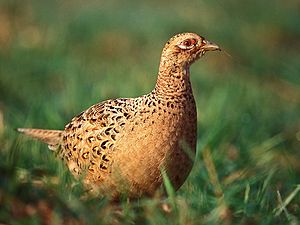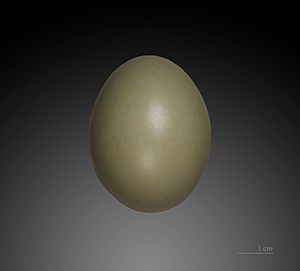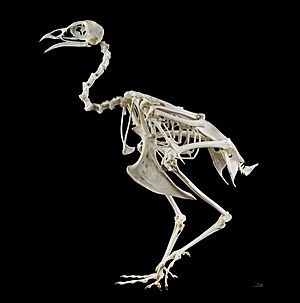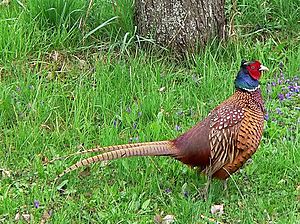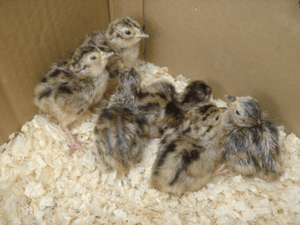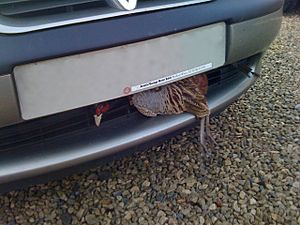Common pheasant facts for kids
Quick facts for kids Common pheasant |
|
|---|---|
 |
|
| Male ("cock") | |
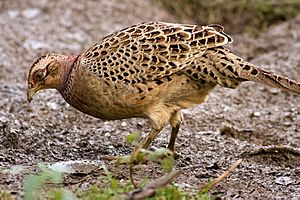 |
|
| Female ("hen") both in England |
|
| Conservation status | |
| Scientific classification | |
| Genus: |
Phasianus
|
| Species: |
colchicus
|
 |
|
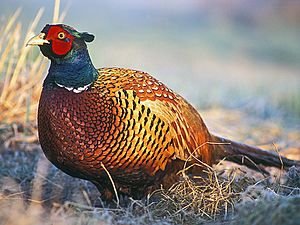
The common pheasant (Phasianus colchicus) is a beautiful bird that belongs to the pheasant family, called Phasianidae. Its scientific name, Phasianus, comes from a Latin word for pheasant. The second part, colchicus, means "from Colchis". This was an ancient country near the Black Sea in what is now Georgia. Europeans first learned about pheasants from this area. Pheasants are related to chickens, but their family lines separated about 20 million years ago.
These birds are originally from Asia and some parts of Europe, like the Caucasus Mountains and the Balkans. However, people have brought them to many other places around the world, especially for hunting. In some areas, like Europe, where no other similar birds live, it's simply known as the "pheasant." In North America, it's often called the ring-necked pheasant. This name also refers to certain types of pheasants that have a white ring around their neck.
The common pheasant is one of the most hunted birds in the world. It's very popular for sport and is raised on special farms for this purpose. The ring-necked pheasant is even the state bird of South Dakota. It's one of only three US state birds that isn't originally from the United States.
The green pheasant (P. versicolor) from Japan looks very similar to the common pheasant. These two types of pheasants can even have fertile babies together if they live in the same area. However, green pheasants usually do better in their natural Japanese homes. This is why introducing common pheasants to Japan hasn't been very successful.
Contents
What Does a Common Pheasant Look Like?
Male common pheasants come in many different colors. They can range from almost white to very dark, nearly black. These different colors are often due to pheasants being bred in captivity and mixing with other types, including the green pheasant. The "ring-necked pheasants" you see in Europe, North America, and Australia are usually a mix of different pheasant types.
A common pheasant can weigh from about 0.5 to 3 kilograms (1.1 to 6.6 pounds). Males are usually heavier, averaging 1.2 kg (2.6 lb), while females average 0.9 kg (2.0 lb). Their wings can spread from 56 to 86 cm (22 to 34 inches) wide.
The adult male common pheasant is quite striking. It can be 60 to 89 cm (24 to 35 inches) long, with a long, streaked brown and black tail that can be almost 50 cm (20 inches) long by itself! Their body feathers are bright gold or fiery copper-red and chestnut-brown. They often have a shiny green and purple look. Their wings are white or cream, and their tails usually have black bars. The male's head is a shiny bottle green with a small feathery crest and bright red skin around its eyes called a wattle. Some types of pheasants don't have a white neck ring. Behind their face, they have two small ear-tufts that help them stay alert.
Female pheasants, called hens, and young birds are much less colorful. They have duller, mottled brown feathers all over. They are about 50 to 63 cm (20 to 25 inches) long, including a tail of about 20 cm (8 inches). Young males look like females until they are about 10 weeks old. Then, they start to grow their bright, colorful feathers on their chest, head, and back.
The green pheasant from Japan is very similar. Male green pheasants usually have shorter tails and darker, uniformly bottle-green feathers on their chest and belly. They never have a neck ring. Female green pheasants are also darker, with many black dots on their chest and belly.
You might also see pheasants with unusual colors. Some are very dark, almost black, called Tenebrosus pheasants. Others are very light, like a pale yellow or fawn color.
Pheasant Family Tree
The common pheasant was first officially described by a scientist named Carl Linnaeus in 1758. He gave it the scientific name Phasianus colchicus. This name means "pheasant from Colchis", which is the area in modern-day Georgia where these birds were first well-known.
In the United States, common pheasants are widely known as "ring-necked pheasants." In China, they are often called zhi ji, which means "pheasant-fowl," or simply shan ji, meaning "mountain chicken."
Scientists have found that the common pheasant's genetic material (its genome) is one of the smallest among all living amniotes (animals that lay eggs with a protective membrane, like birds, reptiles, and mammals). It's about one-third the size of a human genome.
Different Types of Common Pheasants
There are about 30 different types, or subspecies, of common pheasants. These are grouped into five to eight main categories. You can often tell them apart by looking at the male's feathers. Things like whether they have a white neck-ring, the color of their upper tail and wing feathers, and the color of their head, chest, and back feathers help identify them.
However, pheasants that have been introduced to new places often mix together. This means their genes get blended, and you might see birds with features from several different types. This mixing depends on where the original birds came from and how they adapted to their new homes.
Scientists believe the earliest type of common pheasant likely came from the forests of southeastern China. They think the different types started to separate about 3.4 million years ago. The reason it's hard to match how pheasants look with their genetic family tree is because they were separated in the past. But then, as pheasants spread across Europe and Asia, different groups mixed again.
Sometimes, people divide this species into two main groups: the Central Asian common pheasants and the East Asian ring-necked pheasants. These groups are roughly separated by dry, high mountain areas. While these groups were probably completely separate during the last ice age, they weren't apart long enough to become entirely different species. Today, you find the most variety of colors where these western and eastern groups meet and mix. It's usually very hard to tell female pheasants apart by their subspecies.
Many native pheasant types are in danger because they are mixing with pheasants that have been introduced by humans. For example, the last native black-necked pheasants in Europe live in Greece, near the Nestos River. In 2012, there were only an estimated 100–250 of these birds left.
The main groups of subspecies, from west to east, are:
| Subspecies Group | Where They Live | What They Look Like | Image |
|---|---|---|---|
| WESTERN CLADE – Red-rumped pheasants: |
These pheasants have lower backs, rumps, and upper tail-coverts that are generally bronze-red, maroon, or rusty-orange. Sometimes they have a green shine. The black bars on their tail are usually thin. | ||
| Colchicus group – Black-necked pheasants: colchicus, septentrionalis, talischensis, persicus |
From the Caucasus Mountains to western Turkestan, Turkey, and Greece. | They do not have a neck ring. Their wing feathers are buff to brown (or grayish white in persicus). Their upper tail feathers are rusty to chestnut. |  |
| Chrysomelas/principalis group – White-winged pheasants: principalis, zarudnyi, zerafschanicus, bianchii, chrysomelas, shawii |
Central Turkestan and western Tarim Basin. | They have no neck ring or only a very faint one. Their wing feathers are white. Their upper tail feathers and overall body color are bronze to brown. | |
| Mongolicus group – Kyrghyz pheasants: turcestanicus, mongolicus |
Northeastern Turkestan and nearby Xinjiang, China. (Note: mongolicus does not live in Mongolia.) | They have a wide neck ring. Their wing feathers are white. Their upper tail feathers are rusty to chestnut, and their body color is copper. |  |
| Tarimensis group – Tarim pheasants: tarimensis |
Southeastern Turkestan around the eastern Tarim Basin. | They have no neck ring or only a very faint one. Their wing feathers are buff to brown. Their upper tail feathers are dark khaki to light olive green. |  |
| EASTERN CLADE – Grey-rumped pheasants: |
These pheasants have lower backs, rumps, and upper tail-coverts that are light blue-grey, greenish-grey, or olive-greenish. They have a rusty orange patch on each side of the rump. The black tail-bars are generally wide. | ||
| Elegans group – Yunnan pheasants: elegans, rothschildi |
Eastern Tibet, western Sichuan, northwestern and southeastern Yunnan (China), northwestern Vietnam, and northern Myanmar. | They do not have a white neck collar or white lines above their eyes. A wide band of shiny dark green or bluish-green runs down their belly, separating the brassy-chestnut color on the sides of their chest. Their crown is dark green. Their upper tail feathers are light bluish-grey. | |
| Strauchi/vlangalii group – Western grey-rumped pheasants: hagenbecki, vlangalii, satscheuensis, edzinensis, strauchi, sohokhotensis, alaschanicus, suehschanensis, kiangsuensis |
Qaidam Basin, eastern Qinghai, northeastern Sichuan, Inner Mongolia, Gansu, Ningxia, Shanxi, Shaanxi, western Hebei (China). (Note: kiangsuensis does not live in Jiangsu.) | Except for hagenbecki, their white neck collar and lines above their eyes are usually either missing or very narrow. The brassy-chestnut color on their chest is stronger than the shiny green. Their crown is usually dark green (grey in hagenbecki). | |
| Torquatus group – Chinese ring-necked pheasants: pallasi, karpowi, torquatus, takatsukasae, decollatus |
Widespread in eastern China, extending to northern Vietnam and the Strait of Tartary region. (Not found in Hainan.) Most pheasants in North America belong to this group. | The white neck ring can be wide (in the northeast) or missing (in the southwest). Their wing feathers are tan to light grey. Their chest is copper red to light brown-red. Their crown varies from dark green to light grey with white lines above the eyes. | |
| Formosanus group – Taiwan pheasants: formosanus |
Taiwan | They have a white neck ring that is broken at the front. Their flank feathers are typically whitish or pure white with black tips and often thin black edges. The feathers on their chest have wide black edges, making them look scaly. |  |
| Examples: | |||
| P. c. pallasi (Manchurian ring-necked pheasant) |
Southeastern Siberia, northeastern North Korea, and northeastern China. | Their feathers are mostly yellow and copper-brown. They have a grayish-green crown with white lines above the eyes. Their white collar is very wide and unbroken. |  |
| P. c. karpowi (Korean ring-necked pheasant) |
Northeastern China and central and southern Korean Peninsula and Jeju Island in South Korea. Also introduced in Hokkaidō, Japan. | They are darker and more richly colored than P. c. pallasi, and their white collar is narrower. |  |
How Common Pheasants Live
Common pheasants are originally from Asia and parts of Europe. Their natural home stretches from the Balkans (where the last truly wild ones live in Greece) across the Black Sea and Caspian Sea regions to Manchuria, Siberia, Korea, mainland China, and Taiwan. These birds live in woodlands, farmlands, bushy areas, and wetlands. In their natural habitat, they prefer grasslands near water with small groups of trees. Large, open farmlands are not ideal for them to live in for long periods.
Common pheasants like to be in groups outside of the breeding season. However, pheasants raised by humans might separate by sex, with males and females using different feeding spots at different times. If they are hunted, they quickly learn to be shy around people. They will run away fast if they hear hunters nearby.
While common pheasants can fly short distances, they usually prefer to run. If something scares them, they can suddenly burst into the air very quickly. They make a distinct "whirring" sound with their wings and often give loud "kok kok kok" calls to warn other pheasants. They fly at about 43 to 61 kilometers per hour (27 to 38 mph) when just cruising. But if they are being chased, they can fly up to 90 kph (56 mph)!
Nesting and Babies
Common pheasants build their nests on the ground. They make a shallow dip and line it with grass and leaves, often hidden under thick plants or a hedge. Sometimes, they might even nest in a haystack or an old nest left by another bird. At night, they sleep in sheltered trees.
Male pheasants often have several female partners, which is common for birds in their family. Female pheasants lay about 8 to 15 eggs, sometimes as many as 18, but usually 10 to 12. They lay these pale olive-colored eggs over a 2–3 week period, from April to June. The eggs hatch after about 22–27 days. The chicks stay close to their mother for several weeks, but they can leave the nest just a few hours after hatching. They grow quickly, learning to fly after 12–14 days, and looking like adult pheasants by about 15 weeks old.
Pheasants eat a wide variety of foods, both plants and animals. They enjoy fruits, seeds, grains, berries, and leaves. They also eat many different invertebrates like crane fly larvae, ant eggs, wireworms, caterpillars, and grasshoppers. Sometimes, they even eat small vertebrates like lizards, small mammals, or small birds.
Pheasants in Europe
Southern Caucasian pheasants (P. c. colchicus) were common in Greece a long time ago. It's a common story that the Greeks brought pheasants to the Balkans when they settled in Colchis. This happened around 600 BC. However, pheasant bones found in the Balkans are much older, dating back to 6000 BC. This suggests that pheasants probably arrived there naturally. It also seems they lived continuously across Turkey, from the Sea of Marmara to the Caucasus. The last remaining native pheasants in the Balkans live in the Kotza-Orman forest in Greece, with only about 100–200 adult birds left. In Bulgaria, they disappeared in the 1970s because they mixed with introduced pheasants from the east.
Besides the Balkans, pheasants also live in Europe north of the Caucasus Mountains. Here, a local type called P.c.septentrionalis still lives purely around the lower Samur River. Efforts to bring pheasants back to other parts of the northern Caucasus might involve mixed types of birds.
Pheasants Around the World
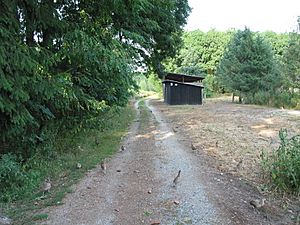
Common pheasants are now found all over the world. This is because they breed easily in captivity and can adapt to many different climates. They have been introduced to Europe, North America, Japan, and New Zealand. People have hunted pheasants in their natural homes since the Stone Age. Since the time of the Roman Empire, these birds have been brought to many places and have become a natural part of the wildlife, especially in Europe. Attempts to introduce them in the Southern Hemisphere have mostly failed, unless there were few or no other similar birds already living there.
The bird became a natural part of Great Britain around 1059 AD. However, they might have been brought there by the Romans centuries earlier. The Caucasian type of pheasant, sometimes called the 'Old English pheasant', was introduced to Britain, not the Chinese ring-necked pheasants. But most of them died out in the early 1600s. More 'white neck-ringed' pheasants were brought in during the 1700s. They became popular again for hunting in the 1830s. Since then, gamekeepers have raised many pheasants, and they are hunted during the season from October 1 to January 31. Pheasants do well in the British climate and can breed naturally in the wild in small woods, open lands, and common areas.
By 1950, pheasants were breeding all over the British Isles, though they were rare in Ireland. About 30 million pheasants are released each year on hunting estates, mostly in the Midlands and South of England. This makes them very widespread, but most of these released birds don't survive for more than a year in the wild. The Game & Wildlife Conservation Trust is studying how well these raised pheasants breed. They are trying to find ways to improve their breeding success so fewer pheasants need to be released, and the wild population can grow. Since the original Caucasian pheasants mostly disappeared, most of the 'dark-winged ringless' pheasants in the UK today are actually mixed types, descended from 'Chinese ring-necked' and 'green pheasant' hybrids.
North America
Common pheasants were first brought to North America in 1773. They have now become well-established in many parts of the Rocky Mountains states (like Colorado, Idaho, Montana, Wyoming), the Midwest, the Great Plains states, as well as Canada and Mexico. In the southwest, you can even see them south of the Rockies in places like Bosque del Apache National Wildlife Refuge in New Mexico. They are most common today on the Great Plains. Common pheasants have also been introduced to much of northwest Europe, the Hawaiian Islands, Chile, Uruguay, Peru, Argentina, Brazil, South Africa, New Zealand, and Australia.
Most common pheasants hunted in the United States are wild birds born in nature. In some states, many of the pheasants are birds that were raised in captivity and then released.
Hunting pheasants is very popular in much of the US, especially in the Great Plains states. Here, a mix of farmland and native grasslands provides a perfect home for them. South Dakota alone has over 1 million pheasants hunted each year by more than 200,000 hunters.
Pheasants and Other Birds
Common pheasants can sometimes have negative effects on other game birds. These include:
- Nest parasitism: This happens when pheasants lay their eggs in the nests of other birds. Pheasants often nest near other birds, and their nesting needs are similar to those of other prairie birds and waterfowl. This has been seen with grey partridges, prairie chickens, and several types of ducks, rails, grouse, and turkeys. If too many pheasant eggs are in a nest, the original bird might abandon it. Also, pheasant eggs hatch faster. If the pheasant chicks hatch first, the mother bird might leave her own eggs behind, thinking they won't hatch. Birds raised by other species might learn unusual behaviors for their own kind. This can sometimes lead to different species mixing and having babies together.
- Competition: Pheasants often compete with native birds for food and places to live. Studies show they can cause fewer bobwhites and partridges because they compete for habitat and food. Insects are an important food source for both pheasants and partridges, and competition can lead to fewer partridges.
- Disease: Pheasants can also spread diseases, like blackhead. While pheasants usually handle this infection well, other birds like ruffed grouse, chukar, and grey partridge are very likely to get sick from it.
- Aggression: Pheasants can also bother or even kill other birds. One study found that in fights between pheasants and prairie chickens, the pheasants won 78% of the time.
Helping Other Birds
Different ways have been suggested to manage areas where other bird species are threatened by pheasants. These ideas include:
- Mowing grass to reduce the thick nesting cover that pheasants prefer.
- Reducing places where pheasants like to rest at night.
- Hunting pheasants in organized hunts.
- Trapping and moving pheasants away from areas where there are many threatened birds.
Changes in Pheasant Numbers
While common pheasant populations are not in danger overall, their numbers have been going down in the United States over the last 30 years. This is mostly in farming areas. This decline is likely due to changes in farming methods, the use of pesticides, the breaking up of their habitats, and more predators because of changes in crops. Many crops that were good for pheasants (like barley) are not farmed as much now. Instead, farmers grow more profitable crops, like nut trees, which are not good for pheasant survival. Pheasants prefer to nest in areas with lots of grassy cover, so many farm areas are no longer suitable for nesting. Female pheasants also face more danger from predators in areas without patches of grassland.
In the United Kingdom, about 50 million pheasants raised in captivity are released each summer. This number has grown a lot since the 1980s. Most of these birds are hunted during the open season (October 1 to February 1), and few survive for a year. This causes the pheasant population to change wildly, from 50 million in July to less than 5 million in June.
Pheasants as Gamebirds

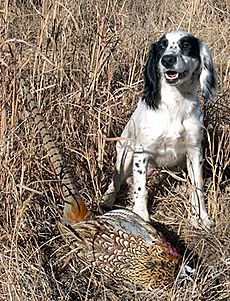
Common pheasants are raised to be hunted. Many are shot in Europe, especially in the UK. Here, they are often hunted in traditional "driven shoots." In these events, hunters pay to have birds driven towards them by people called "beaters." They also hunt them in smaller "rough shoots." The hunting season in the UK is from October 1 to February 1, according to the Game Act 1831. Hunters often use gun dogs, like Retrievers, spaniels, and pointing breeds, to help find, flush out, and bring back the shot birds.
In the 1800s in Britain, hunting pheasants was an expensive sport. It was a popular royal pastime. King George V shot over 1,000 pheasants in six days in December 1913 during a competition with a friend.
Common pheasants have traditionally been targets for illegal hunters, called poachers, in the UK. However, because pheasants are not worth as much money today, some poachers now steal young chicks from pens instead. The Roald Dahl novel Danny, the Champion of the World tells the story of a poacher (and his son) in the United Kingdom who illegally hunted common pheasants.
Raising pheasants on farms is a common practice. These birds are supplied to hunting estates and restaurants. Some are also sold to people who want to cook them at home.
In the past, hunted pheasants were often hung for a while to make the meat taste better, similar to other game meats. Today, people usually cook farm-raised female pheasants by roasting them. In the UK and US, game meat has become more popular in cooking. More pheasants were sold in supermarkets in 2011 than ever before. A big reason for this is that people are choosing to eat more white meat instead of red meat.
See also
 In Spanish: Faisán vulgar para niños
In Spanish: Faisán vulgar para niños



